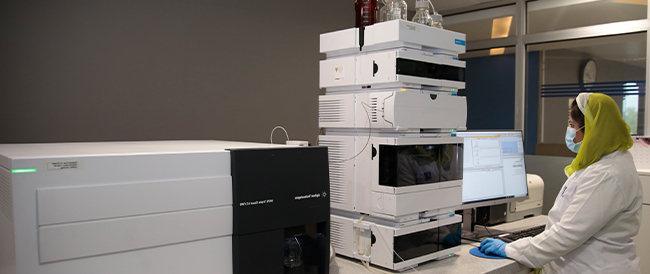
Clinical and Forensic Toxicology Department
The Clinical and Forensic Toxicology Department has been established under the umbrella of Chughtai Healthcare to provide credible and reliable services to the nation of Pakistan. This laboratory’s work is based on international toxicology guidelines and standard operating procedures and has secured accreditation from two international accreditation bodies: The College of American Pathologists (CAP) and ISO-15189. This is the only CAP-Accredited Toxicology laboratory in Pakistan.
The international standards we have adopted include:
- Witnessed specimen collection procedure (to ensure donor specimen identity)
- Consent declaration and chain of custody documentation (to ensure specimen integrity)
- State-of-the-art testing facility equipped with the latest technology like UHPLC-MS/MS, Tox-Analyzer GC-MS, Headspace GC-FID, Atomic Absorption Spectroscopy, etc.
- Specimen validity test (to discourage drug test beating by the donor and rule out specimen substitution and/or adulteration)
- Rapid urine drug screening based on the Substance Abuse and Mental Health Services Administration (SAMHSA) cut-off values
- Confirmatory tests for positive-screened samples
- Technical & Administrative review and reporting
- Interpretation of results & court testimony, on request
The addition of accurate and reliable drug testing using hair and blood specimens has complemented urine drug testing and can aid in combating organizations devoted to suborning drug testing through adulteration, substitution, and dilution. For example, hair testing may detect chronic drug exposure from weeks to years and is a useful tool in pre-admission, pre-employment, and on-the-job workplace/forensic drug testing. Our state-of-the-art instruments and validated methodologies make our tests reliable and efficient.
Currently, we are offering the following testing services:
- Urine Drugs of Abuse Screening Panel
- Targeted drugs of abuse Panel in Hair
- Targeted drugs of abuse Panel in Blood
- Qualitative Confirmation Panel 1 (Opiates, cocaine, & their metabolites) in urine, blood, or hair samples
- Qualitative confirmation of each drug class, like Cannabinoids, Benzodiazepines, Opiates/ Opioids, Cocaine, Amphetamines, Phencyclidine, etc,. in urine, blood, or hair
- Quantitative confirmation of Cannabinoids in urine
- Nicotine and cotinine levels in blood or urine
- Qualitative Confirmation of Nicotine and Cotinine in Hair
- Blood Alcohol concentration
- Urine Alcohol Concentration
- Blood carbon monoxide qualitative confirmation
- Poison screening tests (Paraphenylenediamine, Cyanide, Phosphine, Arsenic, Mercury, Salicylates, Methanol, etc.)
- Serum Vitamin A test
- Serum Vitamin E test
- Serum Copper test
We are also offering research sample testing for unknown compounds, quantification of compounds, pesticide residue testing, organic volatiles impurities, etc.
Who can benefit from these tests?
- Academic Institutions (Schools, Colleges, Universities)
- Law enforcement Agencies (Police, Lawyers, etc.)
- Civil Aviation Authorities
- Medical doctors & Medico-legal examiners
- National & Multinational companies/ organizations
- Sports bodies/ organizations
- Olympic Associations
- Rehabilitation centers
- Researchers
The toxicology department is leading & successfully running a nationwide campaign, “Drug Free Pakistan, “ to combat the menace of drug abuse in Pakistan.





